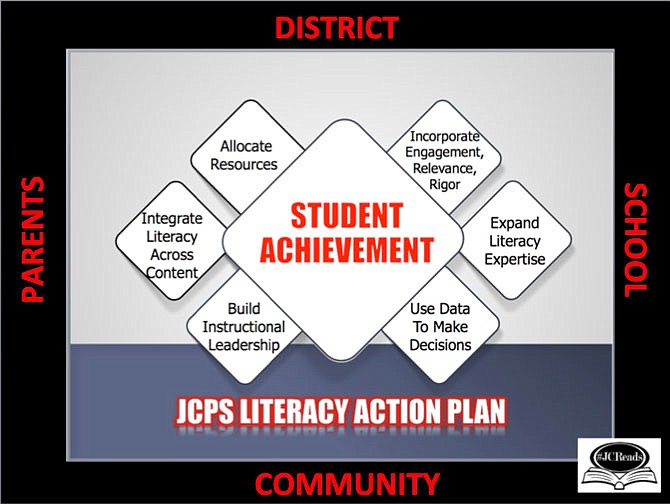Jefferson City Public Schools has been in the process of establishing plans, relationships and positions to ensure its goal of having all students read at or above their grade level becomes a reality.
"We are finally bringing all these pieces together," JCPS Chief of Learning Brian Shindorf said Friday.
Shindorf, Director of Elementary Education Lori Rost and Director of Secondary Education Gary Verslues have been presenting different parts of the district's plan over the past couple months at Board of Education meetings as the pieces take shape.
The district's "literacy cadre" has created a district-wide action plan framework to support and promote literacy. The cadre itself is a new body of people put in place this year, Shindorf explained Friday - 15 people who are teachers, principals and other staff members and serve in a representative role as part of the cadre.
Shindorf has explained to the board that the cadre is a "sounding board" and a "feedback forum so that we can be sure we are providing the services and meeting the needs out at the building level."
The six-point, district-wide action plan framework that the cadre has formed is by itself a broad framework of priorities: "integrate literacy across content; build instructional leadership; use data to make decisions; expand literacy expertise; incorporate engagement, relevance, rigor; allocate resources."
Shindorf said a lot of work has happened and will continue to happen underneath each one of those broad headings, though.
As one example, the district has hired eight new reading interventionists, for a total of 22. Reading interventionists focus on working with the neediest students with reading discrepancies, Rost said.
With the new hires, every elementary and middle school will have access to reading interventionists - between one and three for each elementary school, Shindorf said.
That means the number of students who interventionists will be able to work with will expand significantly, from about 350 students now to 600-700 next year. This doesn't include middle school students, who number about another 120, Title I literacy trainer Stacey Gregory said.
Shindorf said that's been made possible by the district's central office loosening some of its control over how Title I federal funding is distributed and letting each school building make decisions about how best to serve their needs.
Title I refers to federal education standards that fund school services for students in low-income families. Shindorf said funds are allocated based on buildings' percentage of students eligible for free or reduced-price lunch.
Julie Schaefer, the district's K-12 English curriculum coordinator, added reading interventionists also will work with a new group of students every semester and see those students every day, as opposed to the current arrangement of working with the same group of students all year on an every other day basis.
Rost has told the board elementary principals also will be more involved in literacy efforts.
There will be one English "lab classroom" in each elementary building in kindergarten and first, third and fifth grades next year. The kindergarten and third-grade classrooms were in place this year.
Rost has told the board the idea of lab classrooms that are models of the literacy approaches the district wants to implement is to encourage new teachers and their mentors to come visit with a goal in mind, observe and take ideas back to their classrooms to implement - and have principals hold the new teachers accountable to their goals.
Shindorf said the goals are about creating measures for administrators and faculty to work together to identify needs, not evaluations of job performance.
Verslues said the middle schools will not have lab classrooms for now. Teachers apply to have their classrooms be model ones, and it's hoped that middle school teachers will be inspired to apply based on what they see at the elementary level.
Consistency of support structures throughout the K-12 system is a chief aim of the district's broad literacy action plan - including in the transition for students between elementary and middle school.
Rost said the primary focus of literacy support efforts will be with students in kindergarten, first and second grades - "building the foundation" - but Schaefer added there's already been professional development training for middle school teachers, including curriculum planning, to be prepared for when the elementary students come to middle school under the new support system.
Shindorf has informed the board that teachers in grades six through eight have been part of literacy team meetings.
"During these half-day events, the grade-level teachers were taught the use of interactive read-aloud practices," he said. "The strategies engage kids in text through a read aloud and interactive questioning. These trainings are a series we are doing with grades six through eight over three sessions."
All teachers throughout the district - not just of English - will be expected to take part in promoting literacy, too.
"Although it's already being used in many of our buildings, the expectation come August is that we're going to have all of our staff, regardless of the content, regardless of your class, regardless of your grade level, we're going to provide literacy support structures to our kids," Shindorf has told the board.
Verslues said building administrators will communicate specific expectations to teachers. He said even in a class like weightlifting for high school seniors - beyond the age where students are taught the basics of how to read - there are opportunities to engage students in critical reading - incorporating analyses of news articles that fit with that class's curriculum, for example.

